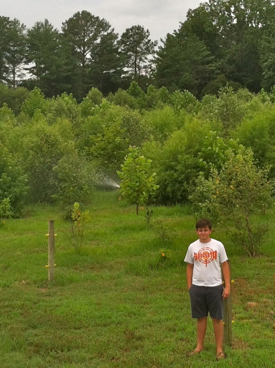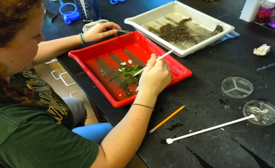Governor’s School students enjoy apprenticeship at VIMS
A half-dozen students from high schools throughout Virginia completed their Governor's School program at the Virginia Institute of Marine Science on July 20, gaining hands-on field and lab experience through projects focused on everything from clams and oysters to blue crabs, seagrass, and willow oaks.
Elliott Theuerkauf, a rising senior at Gloucester High School, says his Governor School experience helped him “learn the ins and outs of scientific research.” He says his mentors, professor Jim Perry and graduate student Wes Hudson, “taught me how scientific research is truly conducted, and that is something that is quite valuable.”
Taylor Medley, a rising senior at Northside High School in Roanoke, says the program “helped me realize how much I love science and set in stone that I want to be doing this for the rest of my life.”
The VIMS Governor's School is a 4-week summer offering that has been providing participants with authentic experiences in marine research since 1993. Each summer, VIMS hosts up to 6 students who have demonstrated interest in and aptitude for marine science. The program is administered in tandem with a similar program at NASA Langley.
“Our Governor’s School apprenticeships offer a wide variety of research opportunities,” says VIMS professor and program coordinator Rochelle Seitz. “Each student’s experience is as different as their mentors’ research interests, but what they all gain is a deeper understanding of their specific project and a greater appreciation for the challenges and rewards of marine research.”
Joining Theuerkauf and Medley in the VIMS program were Elias Bearinger (Tandem Friends High School, Charlottesville); Amelia Johnson (Herndon High School); Julia Johnston (Mathematics and Science High School at Clover Hill, Midlothian); and Thomas Moss (Norfolk Academy).

Research Projects
Theuerkauf’s project focused on planted tree growth within a large-scale field experiment in New Kent County designed to investigate ways to enhance restoration of forested wetlands. He says the research is important because “it helps enhance the knowledge behind created wetlands, which can help wetland restoration efforts tremendously.”
Theuerkauf says the most memorable part of his experience at VIMS “was the dedication and commitment of my mentor to the success of my research. There were many days when Wes went beyond the call of duty and stayed after to help out my project. He put in many hours of help and also bought the occasional BBQ sandwich.”
Hudson was struck by Theuerkauf’s enthusiasm, and says “Elliott showed a lot of independence in using observations to come up with his own good research questions.”
Medley, mentored by professor Rom Lipcius and Master’s student Megan Wood, compared aerial photographs with climate data over a five-year period to better understand the factors responsible for decreasing seagrass populations in the Lynnhaven River. She says her research is important because “seagrass is an essential part of coastal ecosystems and is experiencing a rapid decline in the Bay. If we’re able to pinpoint certain stressors and combat them, there’s a better chance of seagrass surviving and thriving in the Bay again.”
She adds “The scientists at VIMS are some of the most amazing people I‘ve ever met. Everyone is so friendly and so passionate about their work. It's refreshing to be surrounded by knowledgeable people who are interested in the same things as you are.”

Bearinger worked with Seitz and Master’s student Cassie Glaspie to study the survival of soft-shell clams in the face of predation by blue crabs and cownose rays. These clams are an important link in Bay food web and once supported a profitable commercial fishery, but have fallen on hard times in recent years.
Johnson, mentored by professor Rom Lipcius and Ph.D. student Allison Colden, studied how burial by silt affects oyster growth and mortality in Chesapeake Bay. Siltation from waters muddied by development in the Bay watershed is one of the main challenges to oyster restoration in Virginia and Maryland.
Johnson says her favorite part of the Governor’s School experience was “just to be surrounded by people who have the same passions as I do. We all understood each other well.” She adds “the internship demonstrated that research isn’t always exciting: papers have to be written, graphs have to be made—marine science isn’t just about being with marine animals.”
Johnston, mentored by Seitz and Master’s student Theresa Davenport, examined how shoreline development affects the levels of predation faced by nearby bottom-dwelling organisms. Work by Seitz and colleagues has shown that the widespread placement of bulkhead or stone rip-rap along the otherwise marsh-lined shores of tributaries throughout Chesapeake Bay has significantly changed local ecosystems.

Moss worked with professor Donna Bilkovic and marine scientist Molly Mitchell to investigate whether mussels are a good candidate for use in “living shoreline” treatments. Their study showed that the ribbed mussel—a native bivalve—filters waterborne particles at rates similar to those reported for oysters, suggesting that planting these shellfish along with oysters in living shorelines could provide further help in improving Bay water quality.
Mitchell says “Thomas absolutely exceeded our expectations. He had read the primary literature on his own before arriving at VIMS, and came with a great idea that became part of his project—a comparison of ammonium excretion in mussels and oysters.”
Future Plans
“The Governor’s School program is a wonderful way for aspiring scientists to get a hands-on feel for a career in research,” says Seitz. It can also serve as an important step in deciding whether to pursue a science-related major in college, with both Theuerkauf and Medley now planning to apply to William and Mary.
Says Theuerkauf, “My experience here at VIMS has made me want to go to William and Mary because of the fact that I now love the culture of the college. My experiences also make me appreciate environmental policy even more. I plan on either becoming an environmental lobbyist or environmental lawyer when I graduate and my ultimate career goal is to hold an office in Congress.”
Medley—who hopes to attend William and Mary in the fall of 2013, with a double major in Biology and Environmental Science and Policy—says her most memorable part of Governor's School “is a collage of small moments: finally catching a female terrapin after eight tries, eating lunch on the water, finishing my research paper, flipping over Dr. Perry's outrigger while paddling and talking to him about college, helping Elias sort 32 clam samples, and just a lot of small things that made this experience a once-in-a-lifetime sort of thing.”


